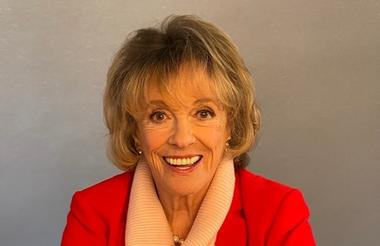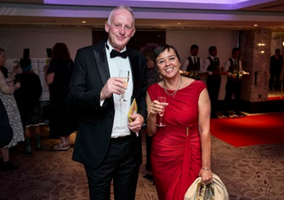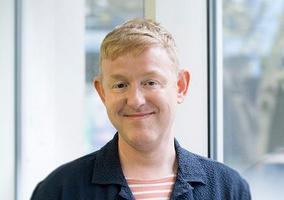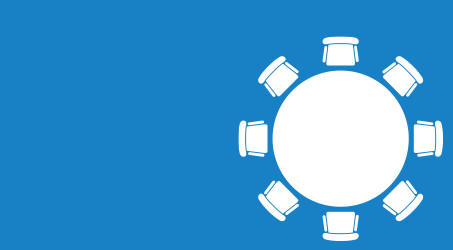On the 25th anniversary of the Daniel Phelan Award for Outstanding Achievement, it seems rather fitting that it should be given to someone who launched their flagship charity many years before the Charity Awards were even an idea.
Childline was created in 1986, the brainchild of TV presenter, campaigner and all-round national treasure Esther Rantzen. Esther had been presenting and producing the iconic consumer affairs programme That’s Life! for 13 years, tackling serious issues such as organ transplants, safe playgrounds and seatbelts alongside more lighthearted subjects such as talking dogs, jobsworth awards and comical misprints. The show was enormously popular, a staple of UK Sunday evenings, drawing audiences of up to 22.5 million.
Esther had been horrified by news of the murder of toddler Heidi Koseda, who had starved to death locked in a bedroom in 1984. She suggested to BBC1 controller Michael Grade that That’s Life! should air an episode called Childwatch, which would invite people to participate in a survey if they had experienced cruelty or abuse as a child. The producers also decided to open a helpline immediately after the show aired, so that any young viewers could call in and ask for help if they were experiencing abuse. The programme aired on 30 October 1986 and the helpline stayed open for 48 hours. It was swamped with calls, mainly from children who were being sexually abused. More than 50,000 calls were made on the first night alone.
This huge level of demand convinced Esther that such a service should be available permanently, open 24/7 throughout the year, to answer calls from children in distress. In her book Running Out of Tears, which she wrote to tell the story of Childline and some of the children it has helped, she said this: “I will never forget walking into my office the morning after the programme to meet the social workers who had been running the helpline. I knew in that moment that working to help protect abused children was far more important to me than any of my previous work. As I heard about these hidden children, all guarding a terrible secret, I passionately wanted to be able to help them. It was the most important cause I had ever worked for. And I realised that if we could keep our lines open throughout the year, we might be able to help hundreds, maybe thousands more children.”
So she set about drumming up support for the concept. The Variety Club and the Department of Health stumped up £25,000 each. Philanthropist Ian Skipper agreed to underwrite the helpline’s first-year running costs and BT chairman Sir George Jefferson provided an office and an easy-to-remember freephone number – 0800 1111 – which still, to this day, doesn’t show up on phone bills. And 40 generous individuals agreed to volunteer to answer the phones.
Today, Childline has 12 bases around the UK, including two each in Wales, Scotland and Northern Ireland, as well as a virtual online base and around 1,100 trained volunteer counsellors. Esther was herself a volunteer counsellor and she chaired the charity’s board for 20 years until it merged with the NSPCC in 2005, enabling it to expand to meet growing demand. She then became a trustee of the NSPCC and president of Childline.
The charity attracted a long list of celebrity support, including from George Michael, Fiona Bruce, Gloria Hunniford, John Cleese, John Hurt, Ant & Dec, Cherie Booth and Diana, Princess of Wales.
When it launched, the charity’s ethos was genuinely groundbreaking. The service has always been confidential, so counsellors will never share what young people tell them without consent, unless they believe the caller is in imminent danger, seriously hurting another person, or being abused by someone in a position of trust. Every effort is made to let the child decide what should happen next, by encouraging them to talk about their lives and building their confidence to the point where they feel safe to confide in an adult that they trust. As Esther wrote in Running Out of Tears: “By launching Childline so that children themselves could ring for help, we were putting children in charge of their own lives. It was up to them to decide to ring, and when, and up to them whether to put Childline’s suggestions into practice. All of which was blasphemy at the time.
“In a way it may have helped me that I have no professional background in child protection or social work. If I had, I might have thought it impossible, or inappropriate, to put such crucial decisions into a child’s hands. It was a revolutionary concept.”
Testimonies from survivors featured in the book affirm that the approach works. One young person wrote: “The thing is, they give you ideas that might not occur to you otherwise. They don’t try and force you, they just suggest things and ask whether you think it would work out.” Another said: “I must have made nearly a dozen calls to Childline. Each time I spoke to someone different but it didn’t matter because it was Childline I trusted and they were all fantastic. They helped me turn my life into something positive. Without them I would be dead. I would say to any unhappy child, take the chance, ring them. They can’t change your life for you, but they can help you change your life yourself.”
In the 39 years that Childline has been running, it has helped children and young people on more than six million occasions. Last year alone, the volunteer workforce provided almost 200,000 counselling sessions. As well as the 24/7 helpline and online counselling service, its website features a host of information and tools for young people, plus interactive messaging boards where they can connect with others. And the helpline model has been copied in 150 countries, reaching millions more.
Childline was also the inspiration for the creation of another charity for survivors of child abuse – NAPAC, the National Association for People Abused in Childhood. Its founder, Peter Saunders, had suffered neglect and abuse throughout his childhood, and he phoned Childline for the first time at the age of 38. Although he realised there was nothing Childline could do for him now, his life was nevertheless transformed by that phone call. It gave him the idea for an organisation to support adult survivors of child abuse – a sort of Childline for adults – and NAPAC was registered as a charity in 1998. It has provided direct telephone or email support to over 60,000 survivors since then.
In Childline’s first few years, the main issue the children reported when they called the helpline was sexual abuse, and around a fifth of these children said they had been subjected to the abuse for more than five years. By the first decade of the 2000s, bullying had overtaken sexual abuse as the most common problem cited by young callers.
In the last two years, the top five concerns for young people contacting Childline were mental/emotional health, suicidal thoughts, family relationships, self-harm and friendship issues – not sexual abuse. Mental and emotional health remains the top concern for young people contacting Childline and accounted for more than one in three counselling sessions last year.
As Esther wrote in Running Out of Tears: “Abuse creates a horrible chain that has stretched back to the dawn of time, but I think now, since the advent of Childline, with all the changes in attitude and other improvements in child protection we may come to a place where that hideous chain is finally broken. And breaking that chain will be the most crucial gift of love towards all children.”
Esther’s other charities
While Childline was Esther’s principal charity project, she has also campaigned, fundraised for and supported more than 50 other charities and causes throughout her life, with a particular focus on children, older people and those with disabilities.
Among these, she was vice-president of respite charity Revitalise; patron of older people’s charity Erosh; and a patron of Operation Encompass, which last year enshrined in law a statutory duty for police forces to notify schools if they believe a pupil is a victim of domestic abuse.
In 2013 she launched a new helpline charity, the Silver Line, for older people who are lonely or vulnerable. Staff and volunteers at the Silver Line answer around 170,000 calls a year and, where appropriate, signpost callers to further services for specialist or longer-term support. Since its launch, it has answered more than four million calls.
The charity also provides a telephone befriending service, where trained volunteers make weekly calls to older people, or facilitate group calls called Silver Circles. In 2019, the Silver Line became part of Age UK, and the two charities’ friendship services were merged to create the Telephone Friendship Service, which continues to run along with the 24/7 Silver Line Helpline.
Consummate campaigner
Alongside Esther’s tireless work to launch and grow Childline, she also continued to use her platform on That’s Life! to promote countless more causes. In total, the programme ran on BBC1 for 21 years, during which time it shone a spotlight on hidden or underreported health conditions including chronic fatigue syndrome and post-natal depression, raised awareness of teenage bullying, and agitated successfully for abused children giving evidence in court to be able to do so via videolink.
The most viewed – and emotionally charged – episode featured Sir Nicholas Winton being reintroduced, in 1988, to a roomful of the 669 children that he had rescued from Nazi-occupied Czechoslovakia 50 years earlier. After That’s Life! finished in 1994, Esther devised, presented or appeared on many other TV programmes, including making a documentary for ITV called Winton’s Children, chronicling the story of Sir Nicholas’s heroic deeds. She also created the Children of Courage and Achievement segment of BBC Children in Need, which recognised young people who have shown extraordinary character and braveness in the face of adversity, or accomplished great things.
She was far ahead of her time on many societal issues. For instance, on the Parkinson talk show in 1977, she challenged fellow guest Bernard Manning over his racist humour, labelling it as “dangerous” because it “provides a veneer of respectability to racist prejudice”.
End-of-life choices
Esther was married to filmmaker Desmond Wilcox, with whom she has three children: Miriam, Rebecca and Joshua. A few years after Desmond died in 2000, she made a landmark programme for BBC Two called How to Have a Good Death, which followed the journeys of patients and their families navigating the palliative care system and examined government policy and the options available to people at the end of their lives. She could not have imagined at the time how personal this issue would become.
In 2023, aged 82, Esther issued a public statement declaring that she had been diagnosed with terminal lung cancer. She also voiced her support for the Dignity in Dying campaign group, which launched a petition and sought a parliamentary debate and a free vote to change the UK law which criminalises assisted dying. And she revealed that she had joined Dignitas in Switzerland, to ensure she had the choice of dying pain-free and with dignity.
“But I will have to go alone to ensure my nearest and dearest are not charged with my murder,” she said, before urging all the political parties to put “this life and death issue” into their election manifestos.
Since then, Labour has come to power and allowed MPs a free vote on the topic. Esther wrote to all 650 MPs urging them to attend parliament and vote.
The Terminally Ill Adults (End of Life) Bill is still making its way through parliament, having cleared all Commons stages with a historic vote last month. It will now face scrutiny in the Lords, and if it passes there it could become law within four years. After the vote, Esther said: “It won’t come in my lifetime – I won’t live long enough – but I am so relieved it will help future generations to look forward to a good death. I am astonished I have lived to see the moment.”
In March this year, Rantzen’s daughter Rebecca Wilcox revealed that the cancer drug Esther had been taking was no longer effective, and that she was too unwell to travel to Dignitas. But that hasn’t deterred her from continuing the campaign. She has carried on speaking her mind and striving for terminally ill adults at the end of their lives to have more compassion and choice over when, where and how they die.
Esther has led an extraordinary life, combining showbiz and celebrity with charitable service, and using her platform to improve the lives of literally millions of people, including the most vulnerable. She is indeed a star – in the truest sense of the word.
The Esther Rantzen years
1940 Born in Berkhamsted, Herts
1962 MA in English, now Honorary Fellow, Somerville College, Oxford
1963 Sound effects assistant, BBC Radio
1968 Researcher/reporter, Braden’s Week consumer TV show
1973-1994 Producer/presenter, That’s Life!
1977 Married Desmond Wilcox
1986-2005 Founder and chair, Childline
1991 OBE for services to broadcasting
2005-2018 Trustee, NSPCC
2006 CBE for services to children
2010 Stood as independent candidate in Luton South at the general election (and lost her deposit, gaining just 4.4% of votes)
2013 Launched the Silver Line
2015 DBE for creating Childline and the Silver Line
2023 Announced cancer diagnosis and began campaigning for a change to the law on assisted dying
Related articles












